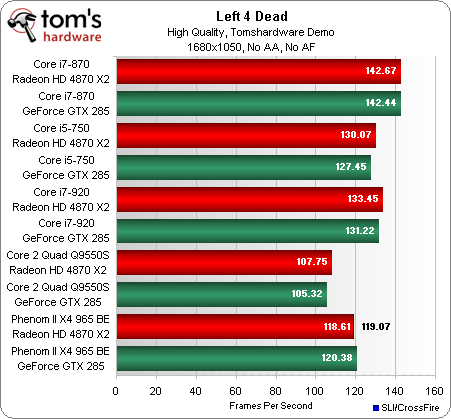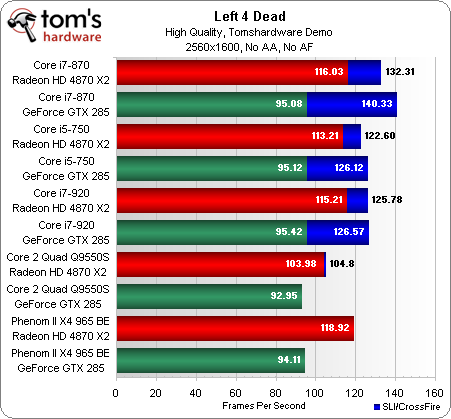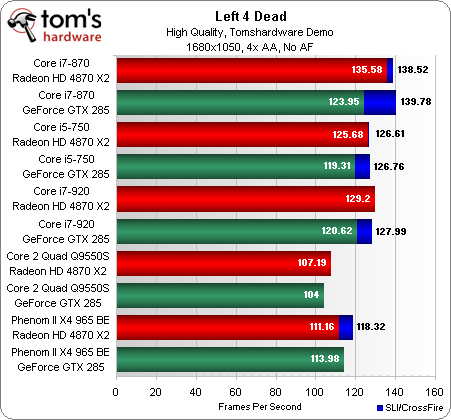Core i5, Core i7, CrossFire, And SLI: Gaming Paradise, Redux?
Benchmark Results: Left 4 Dead
At 1680x1050, Left 4 Dead is entirely CPU-bound. Adding CrossFire or SLI only results in lower frame rates. We do get a great sense for how clock speed affects this game, though—at least between the three Core i5/i7 CPUs. The trio is favored, to be sure. And although the Core i5-750 features a more aggressive Turbo Boost implementation than the Core i7-920, it isn’t able to usurp the X58-based platform. Interesting also is that the ATI and Nvidia cards score identically. The bottleneck couldn’t get any more pronounced.
The competition opens up a little bit at 2560x1600. With a single Radeon HD 4870 X2 installed, AMD’s Phenom II X4 965 actually takes a first place finish, followed by the three Nehalem-based chips. With a GeForce GTX 285, all five platforms perform almost the same, notably slower than ATI’s flagship.
Drop in a second GeForce GTX 285, though, and Nvidia overtakes ATI, if only by a sliver. The Core i7-870, with its 2.93 GHz base clock, proves to be the fastest. Of course, even the lowest result in this chart is ridiculously quick. There’s no reason leave anti-aliasing and anisotropic filtering disabled in Left 4 Dead.
There’s a slight benefit to adding CrossFire or SLI at 1680x1050 with more visual detail applied, but certainly not enough to warrant buying a second graphics card. Again, the Core i7-870 takes a first place finish in this one.
At 2560x1600, with 4xAA and 8xAF enabled, all five platforms turn back the same results with a single Radeon HD 4870 X2 installed. The same happens when you sub-in a GeForce GTX 285, though the Nvidia card is quite a bit slower. Nvidia takes off with the addition of SLI though, sailing past a pair of Radeon HD 4870 X2s. ATI’s cards pick up performance too, but they don’t scale nearly as well.
Even though the cards on our P55-based platforms only get eight lanes of PCI Express connectivity each, the Core i5 and Core i7 systems still manage to out-perform the Core 2 Quad and Phenom II machines under the influences of CrossFire.
Get Tom's Hardware's best news and in-depth reviews, straight to your inbox.
Current page: Benchmark Results: Left 4 Dead
Prev Page Benchmark Results: Far Cry 2 Next Page Benchmark Results: Grand Theft Auto 4-
lashton so we can assume for gaming the 965BE (or 955 oc) and ATi cards are just as fast as Core i7 and i5 but at a fraction of the priceReply -
Dekasav Only thing I don't like is how you knock Crossfire with 2 HD 4870X2's, since when is it even feasible that 4-way CF would scale as well as 2-way SLI?Reply
But excellent review, overall, I'm actually surprised at how the 965BE did, I thought it'd be behind, where it was actually right in the pack. -
dirtmountain I would have liked to see a 780a or a 980a SLI motherboard used to check the SLI numbers on the P2 965BE. I'm also surprised there's no overclocking numbers in the comparison, is that article still to come out?Reply -
cangelini It's upcoming dirt; Patrick is the one working on it (and our Italian team sent word of its i5 and i7s in excess of 4.2 GHz)Reply -
anonymous x ReplyLet us know what you think about this in the comments section, but it was pretty clear that Vista was never a favorite, so we're hoping Windows 7 is a more popular environment in which to test
I like vista, rock solid and stable since I got it years ago. Don't listen to the bashers who never have tried the product. -
lashton You giotta remember vista is design for spoecific hardware and powerfull hardware that can run it, so people with P4 3GHz and vista complain about its speed, vista is OK, i dont like it cause my computer doesm't like it thats fine i get over it and chnage my OSReply -
crash27 So there's no benafit from adding a second 285 to a q9550s or an x4 965 be ??Reply
I get a good performance boost from my second gtx280 with my q9650 @ 4 gz




